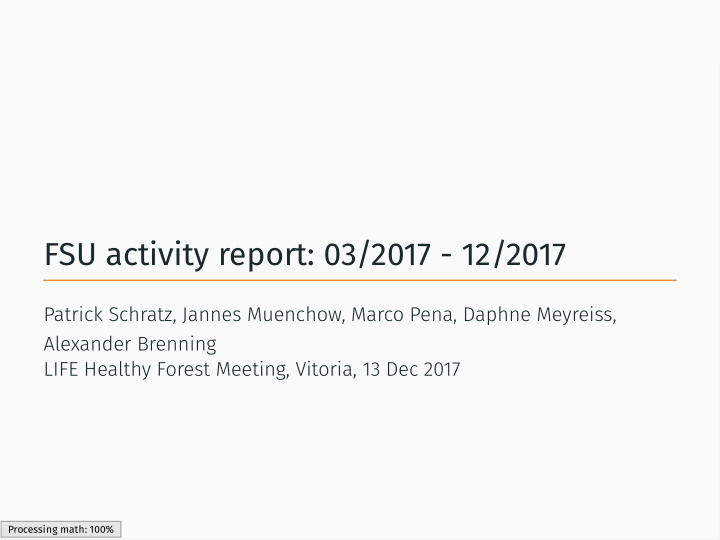



FSU activity report: 03/2017 - 12/2017 Patrick Schratz, Jannes Muenchow, Marco Pena, Daphne Meyreiss, Alexander Brenning LIFE Healthy Forest Meeting, Vitoria, 13 Dec 2017 Processing math: 100%
Outline 1) Action A2.1.6: Acquisition of hyperspectral imagery 2) Action B1.1: Spatial mapping using statistical and machine-learning data analysis 2 / 19
Action A2.1.6: Acquisition of hyperspectral imagery 3 / 19
Acquisition of hyperspectral imagery Prior to March 2017 Hyperspectral imagery was acquired by HAZI in September 2016 for all plots (28 in total) Unfortunately, one of the five demonstration plots ("hernani") was not covered by the flight mission FSU helped with the planning of the flight routes (Marco Pena) Hyperspectral sensors Hyperion-1 was decomissioned in January without prior notice Airborne AVIRIS data as a replacement not suitable (price, flights only in US) No other spaceborne hyperspectral sensor available 4 / 19
Acquisition of hyperspectral imagery March 2017 - Now We decided to acquire spaceborne multispectral Sentinel-2 data as an alternative for Hyperion-1 data. Aim: Time-series analysis of the vegetation period for 2016 and 2017 Why time-series analysis? Due to the offset in both spatial and radiometric-resolution (1m vs. 10m, 126 bands vs. 10 bands) it is not possible to directly compare multispectral images and hyperspectral images. Time-series analysis might reveal changes over time of infested trees by using various indices (e.g. vegetation indices). Possible trends can still be post-analysed with hyperspectral imagery from September 2016. 5 / 19
Acquisition of hyperspectral imagery Acquisition period: March 2016 - November 2016 March 2017 - November 2017 Repetition rate: 10 days So far we acquired 391 images (each 500MB) in total resulting combining to ~ 200GB of raw data. For every of the 27 plots we have 135 images. These got cropped to the respective plot extent leaving a total of 70 MB for the complete time-series. Daphne Meyreiss (student assistant) was in charge of the processing. Pre-processing (Download, cropping) of all plots is planned to be finished at the end of 2017. Deliverable contributions: Remotely-sensed forest health map (06/2018) B1 Integrated analysis of characterization results at large scale (01/2019) B1 Maps of forest disease potential (10/2018) B1 6 / 19
Acquisition of hyperspectral imagery Plot "Caranca" with both hyperspectral airborne and multispectral Sentinel-2 image Multispectral image (Sentinel-2, 10m) Hyperspectral image (airborne, 1m) 7 / 19
Action B1.1: Spatial mapping using statistical and machine-learning data analysis 8 / 19
Action B1.1: Spatial mapping Analysis goal: Which model performs best in classifying infested trees (Diplodia Pinea) using environmental variables as predictors? Predictors: Temperature, precipitation, tree age, soil type, lithology type, pH value, hail damage, elevation, slope Related work: Iturritxa et al. (2014): Spatial analysis of the risk Monterey pine plantations. This worked analysed the influence of the predictor variables using parametric models (GLM, GAM) while the current analysis compared statistical and machine-learning models focusing on predictive performance. 9 / 19
Action B1.1: Spatial mapping Key Points: State-of-the-art parametric and non-parametric models (BRT, GAM, GLM, KNN, RF, SVM) Accounting for spatial autocorrelation by using bias-reduced spatial cross-validation Extensive hyperparameter tuning of machine-learning models to ensure best possible performance results >>> "How-to" guide for bias-reduced spatial model comparison analysis. 10 / 19
Action B1.1: Spatial mapping Performance results 11 / 19
Action B1.1: Spatial mapping Exemplary hyperparameter tuning result 12 / 19
Action B1.1: Spatial mapping Runtime comparison 13 / 19
Action B1.1: Spatial mapping Ridge regression analysis of hyperspectral data Goal: Find vegetations indices which reveal a pattern in defoliation of infested trees B Approach: Calculate all possible vegetation indices + narrow band indices ( ) on B1 B2 different resolutions (1m - 5m). This results in a data set with 30k+ variables which are modelled using ridge regression (M. Pena). Data sets : Demonstration plots (Laukiz I, Laukiz II, Oiartzun, Luiando) 14 / 19
Action B1.1: Spatial mapping Ridge regression analysis of hyperspectral data Pearson’s correlation coefficient between more than 30.000 indices and the observed defoliation in the field (Laukiz I) 15 / 19
Action B1.1: Spatial mapping Ridge regression analysis of hyperspectral data 16 / 19
Action B1.1: Spatial mapping Milestone and deliverable contributions Guide with the identification and characterization of invasive and pathogenic agents (10/2018) B1 Deliverable Integrated analysis of characterization results at large scale (01/2019) B1 Deliverable Developed model of forest disease potential (10/2018) B1 Milestone Data for spatial analysis compiled (10/2018) B1 Milestone Final selection of algorithm for remotely-sensed forest health mapping (10/2018) B1 Milestone Design and study of algorithms (10/2018) B3 Milestone 17 / 19
Outlook 18 / 19
Outlook Modeling of pathogen Armillaria using environmental variables as predictors and utilizing the winning algorithm of the model comparison analysis (Random Forest) Model comparison analysis of defoliation using hyperspectral indices as predictors including hyperparameter tuning Time-series analysis of acquired Sentinel-2 data Analysis of new in-situ data acquired by NEIKER in October 2017 (received this week) 19 / 19
Recommend
More recommend